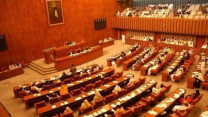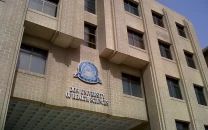Awareness key to coping with climate change: Speakers
Need for disaster risk reduction strategies highlight at a seminar.

Need for disaster risk reduction strategies highlight at a seminar.
Research, awareness campaigns and the integration of disaster risk reduction (DRR) strategies in planning and development are essential to help Pakistan cope with future climate change challenges.
These were the recommendations of a recently conducted survey by Save the Children to assess the impacts of climate change on children and their families in the Indus Basin.
The report’s draft and recommendations were presented by Dr Inayatullah, a climate change expert working with Save the Children, at a seminar in Islamabad on Tuesday titled “Building Resilience in Indus Basin”.
The study was conducted earlier this month. It involved a quantitative survey and focus group discussions with a sample of 200 households-- 703 boys, 634 girls and 269 children under age-five. The study participants belonged to five villages each from districts along the Indus River --- Nowshera, Rajanpur, Shikarpur and Nasirabad.
Inayatullah said the respondents reported an increase in the severity of summer, changes in rainfall patterns, and an increase in mosquitoes, all of which are also signs of climate change.
According to the survey, 80 to 98 per cent of respondents were worried they will run out of money to buy food and 90 to 96 per cent respondents at Rajanpur, Shikarpur and Nasirabad reported their families had to cut the size of their meals or skip them entirely because they could not afford to buy food.

“Climate change is a hunger multiplier since it affects crop yields and agricultural productivity negatively,” Inayatullah said. “Large scale food security will be challenged, not only in Pakistan, but worldwide due to climate change in the coming years.”
Chief Guest Brigadier Sajid Naeem, director of the National Disaster Management Authority (NDMA), said the government is working to improve climate change adaption to prepare against potential natural hazards.
“Pakistan remains vulnerable to climate change and this vulnerability is likely to increasing in the coming decades,” Naeem said. “We must all be prepared for a world which is changing.”
Idrees Mehsud, director of DRR at NDMA, gave a presentation on NDMA’s present and future strategy at the seminar.
“The monsoon zone has shifted 8,200 kilometres west,” he demonstrated, using an animation during his presentation. The shift, which could be due to climate change, was marked to be over the northern Punjab area.
The latter part of the seminar dealt with the role of women in resilience building. Jamila Nawaz, a representative of Oxfam, said the pre-disaster prevailing social conditions make Pakistani women more vulnerable than men in disaster situations.
“It’s not gender, but gender inequality that makes woman and girls more vulnerable when a disaster strikes,” Nawaz said, mentioning the lack of access to education and of economic independence most women in Pakistan face.
Published in The Express Tribune, January 30th, 2013.



















COMMENTS
Comments are moderated and generally will be posted if they are on-topic and not abusive.
For more information, please see our Comments FAQ